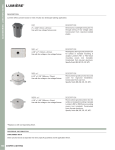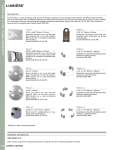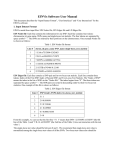Transcript
57º Congresso Brasileiro de Genética Resumos do 57º Congresso Brasileiro de Genética • 30 de agosto a 2 de setembro de 2011 Centro de Convenções do Hotel Monte Real Resort • Águas de Lindóia • SP • Brasil www.sbg.org.br - ISBN 978-85-89109-06-2 73 Troubleshooting the search for potential pathogenic small INDELs (1-10bp) in neuropsychiatric disorders Lemos, RR1; Souza, MBR1; Oliveira, DF1; Pimentel, LF1; Oliveira, JRM1,2. 1 Keizo Asami Laboratory – LIKA – Federal University of Pernambuco, Recife-PE. 2Neuropsychiatry Department Federal University of Pernambuco, Recife-PE. [email protected] Keywords: INDELs, Sequencing, Neuropsychiatric disorder Single Nucleotide Polymorphisms (SNPs) and Insertion or Deletions (INDELs) have been increasingly recognized as a major type of genetic variations, with potential impact in protein activities and gene expression levels observed in complex genetic traits, like neuropsychiatric diseases. However, previous studies have pointed various methodological difficulties to reliably detect and validate short INDELs in a large-scale manner. Various approaches have been developed with bioinformatics tools and molecular techniques for identification and association of these variations and our group recently designed a bioinformatics pipeline to detect new potential variations in genes selected from microarrays studies performed with brain samples from patients with Alzheimer’s disease (AD) and mood disorders (dysthymia and bipolar affective disorder-BPD). We started screening this panel of variations in Brazilian population samples affected by AD and mood disorders to confirm the variations predicted by our original method. The DNA was amplified by PCR and sequenced in a Mega Bace 1000 and fragments were aligned by using the software CLCbio Workbench Combined® version 3.6.2. So far, INDELs predicted In silico, ranging from 1 to 10bp, were not confirmed in any samples. Some false positives were consistently identified but latter ruled out after verification at the complementary strand. We performed preliminary experiments with DNA pooling and they still need methodological adjustments for a better interpretation for the yield and sensitivity but are potentially applicable to save time and resources in such large scale screening. Two genetic variations at the genes COX2 and IL1A were confirmed in AD samples: respectively rs2745557 and rs17561. The rs14068 SNP, located at exon 2 of the GABRA5 gene was validated in samples of patients with dysthymia and BPD. Our group is currently dealing with different approaches that might optimize sequencing and bioinformatics analyses of shorts INDELs to broaden our research capabilities of identifying those intriguing genetic variations. Reporting these pitfalls might contribute with other groups that are planning to search for such interesting genetic variation and call the attention for the high rate of false positives in case of experiments lacking careful checking of double strand sequencing. Financial Support: CNPq, PROPESQ-UFPE, CAPES, and FACEPE.









